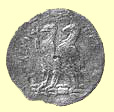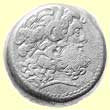
| |
Two Eagles on Ptolemaic Coins as Representations of Co-Regency |
|
  Review of Price's suggestion that two eagles indicate a double denomination
Review of Price's suggestion that two eagles indicate a double denomination
|
|
Return to the beginning part of this review.
In 1981, M. Price reported his study of the coins from excavations at North Saqqâra. A hoard of 75 coins included two types of two-eagle coins, i.e., two examples of Sv1423 and fifteen of Sv1424 (see table below). Price used his view that the two-eagle reverse type is a denominational marker, he therefore treated these two types as the same denomination. Since they had considerable differences in weight, he labeled Sv1423 a "double unit" and the lighter weight Sv1424 a later "reduced double unit" (i.e., reduced in size and weight but the same denomination). He assigned other coins in the hoard (Sv1375 and Sv1494) as "unit" denominations of the "double unit" coins. These relationships and assumptions are shown by the images and given by titles of the coins illustrated in the table. he therefore treated these two types as the same denomination. Since they had considerable differences in weight, he labeled Sv1423 a "double unit" and the lighter weight Sv1424 a later "reduced double unit" (i.e., reduced in size and weight but the same denomination). He assigned other coins in the hoard (Sv1375 and Sv1494) as "unit" denominations of the "double unit" coins. These relationships and assumptions are shown by the images and given by titles of the coins illustrated in the table. Move table to top
|
  |
|


|
| "double unit" |
|
"unit" (when
not countermarked) |
| Sv1423 (two eagles) |
|
Sv1375 (one eagle) |
| 30.9g, 31mm and 36.3g,
35mm |
|
17.1 - 22.4g, 28-30mm |
| |

 |
|
  |
| "reduced double unit" |
|
"[reduced] unit" |
| Sv1424 (two eagles) |
|
Sv1494 (one eagle) |
| 16.0 - 28.8g, 30-35mm |
|
7.5g, 24mm and 11.5g,
24mm |
Source: M. J. Price, Appendix J, ‘Coins’, in The Sacred Animal Necropolis at N. Saqqâra,
(London 1981), p. 160. |
To support his assignments, Price pointed out that all examples of Sv1375 in the hoard had been countermarked with a cornucopia symbol applied in the same place on the flan as in the design of Sv1424. He suggested that the countermarking probably represented a reissuing that doubled the original value of Sv1375. Since coins Sv1424 are almost indistinguishable in size from Sv1375, coins Sv1375 (after countermarking) would then circulate at the same value as Sv1424. Thus, if the countermarking indicates a double unit, both Sv1424 and countermarked Sv1375 are equivalent "reduced double units" with the same value as the "double unit".
It is important to recognize two assumptions as the basis of the argument that Sv1424 is a reduced double unit rather than simply another denomination, i.e., a denomination with less weight, smaller diameter, and a corresponding lower value.
|
The two assumptions (with new data) give contradictory and economically unreasonable results Unknown, of course, to Price in 1981, the "Coinex" hoard that became available in 1992 contained (as did the Saqqâra hoard) examples of Sv1423 (c.40g), Sv1424 (c.29g) and examples of countermarked coins. While the countermarked coins in the Saqqâra hoard were Sv1375 (c.19g), the Coinex hoard contained countermarked coins Sv1140ff (c.45g). While the countermarked coins in the Saqqâra hoard were Sv1375 (c.19g), the Coinex hoard contained countermarked coins Sv1140ff (c.45g). Coins Sv1140ff were originally produced by Ptolemy IV, and they all showed a cornucopia countermark in the same position as on countermarked Sv1375 (produced by Ptolemy VI) in the Saqqâra hoard. Since the Coinex hoard contained coins from the same monetary reform that produced coins in the Saqqâra hoard, Price′s assumptions may be tested by applying them to the Coinex hoard. Coins Sv1140ff were originally produced by Ptolemy IV, and they all showed a cornucopia countermark in the same position as on countermarked Sv1375 (produced by Ptolemy VI) in the Saqqâra hoard. Since the Coinex hoard contained coins from the same monetary reform that produced coins in the Saqqâra hoard, Price′s assumptions may be tested by applying them to the Coinex hoard. Analogous to Price′s treatment of the Saqqâra hoard, if assumption 1 is applied to coins Sv1423 and Sv1424 in the Coinex hoard it would make them the same denomination. If assumption 2 is applied to the countermarked coins Sv1140ff (just as applied by Price to countermarked coins Sv1375), coins Sv1140ff would then be associated with Sv1424 by the countermark and would also double in value. To continue the analogy, because coins Sv1140ff (c.45g) are much heavier than Sv1424 (c.29g) or Sv1375 (c.19g), the heavy countermarked coins would be "increased double units". Thus invoking the above two assumptions leads to producing the same denomination (a double unit) as an increased double unit (countermarked Sv1140ff, c.45g) in the Coinex hoard, while it produced the reduced double units (countermarked Sv1375, c.19g and Sv1424, 16.0-29g) in the Saqqâra hoard. The result is that Price′s two assumptions produce coins that are both contradictory and economically unreasonable. Contradictory because the same denomination (i.e., a double unit) is produced in two widely differing weights that are incongruently reduced with countermarked coins Sv1375 (c.19g) and increased with countermarked coins Sv1140ff (c.45g). Price mentioned that the cause for the countermarking (involving the reduced weight of countermarked Sv1375 and of Sv1424) was surely to be found in the revaluation of the coinage due to severe inflation. The increased weight for the same denomination (i.e., countermarked Sv1140ff) is completely contradictory and unreasonable. Contradictory because the assumptions led to both a decreased weight (Price's result as expected from inflation) and an increased weight (impossible with inflation) for that same denomination (from Price's assumptions applied to the new data). It would be economically unreasonable to produce a double unit denomination by countermarking heavy weight Sv1140ff coins when the same double unit value could be produced by countermarking light weight Sv1375 coins. The increased weight for the same denomination (i.e., countermarked Sv1140ff) is completely contradictory and unreasonable. Contradictory because the assumptions led to both a decreased weight (Price's result as expected from inflation) and an increased weight (impossible with inflation) for that same denomination (from Price's assumptions applied to the new data). It would be economically unreasonable to produce a double unit denomination by countermarking heavy weight Sv1140ff coins when the same double unit value could be produced by countermarking light weight Sv1375 coins. It should be concluded from the above that countermarking did not double the value of coins; i.e., that assumption 2 is not valid. In addition, assumption 1 is cast in doubt when it is the basis for making four different coins (Sv1423, Sv1424. countermarked Sv1375 and countermarked Sv1140ff) into the same denomination all circulating at the same time. That the double-eagle reverse type is not an indicator of denomination has been amply shown in Parts 1, a,b,c of this web site; the universal basis of Ptolemaic denominations are weight (and related size), and these characteristics were not purposely augmented by various aspects of coin types in order to indicate denomination. Countermarking validates older coins to circulate at the denomination of similar weight new coins The explanation for the countermarking of coins Sv1375 and Sv1140ff is that the process rapidly converts some readily available earlier coins to make them equivalent to newly produced coins. They are then efficiently validated to circulate at the same denomination as new coins, similar in weight and diameter, produced by a monetary reform. The cornucopia countermarks simply relate coins Sv1375 (c.19g, c.29mm) to the denomination of newly produced coins Sv1424 (c.29g, 32-35mm) while countermarked coins Sv1140ff (c.45g, 35-38mm) were related to the different denomination of coins Sv1423 (c.40g, 33-38mm). These relationships are shown in the table below. As described at the right, these relationships were recognized by Price and by Lorber. However, they ascribed additional (and invalid) assumptions in their treatments of the two hoards. In this webpage the use of the data from both the Coinex hoard and the Saqqâra hoard gave the results described in the table. |   | |   | | | | | | | | | | | | |   | |   | | | | | | | | | | Source: Saqqâra hoard; M. J. Price, Appendix J, ‘Coins’, in The Sacred Animal Necropolis at N. Saqqâra, (London 1981), p. 160. Source: Coinex hoard; S. M. Huston and C. C. Lorber, ‘A hoard of Ptolemaic bronze coins in commerce, October 1992 (CH 8, 413)’, Numismatic Chronicle, (2001), p. 36 and p. 27. |
| The countermarking of both Sv1375 and of Sv1140ff occurred in the same monetary reform that was postulated by Price and discussed by Huston and Lorber (see references given in the table). Price and Lorber both recognized the same initial effects of the countermarking that are also recognized in this website (i.e., countermarked coins Sv1375 were made equivalent with Sv1424; countermarked coins Sv1140ff were made equivalent with Sv1423). That is, Price equated countermarked coins Sv1375 with coins Sv1424 present in the Saqqâra hoard while Lorber equated countermarked coins Sv1140ff with coins Sv1423 present in the Coinex hoard. She states that "countermarked c.45g coins [Sv1140ff] later passed as equivalent to the large-horn Ammon bronze [Sv1423]". However, additional meanings for the countermarks and for the two eagles, i.e., that the countermarking doubled the value of a coin (Price, Lorber) and that two-eagle reverse type indicated the same denomination for coins Sv1423 and Sv1424 "despite differences in diameter and weight" (Lorber) are unwarranted and are shown here to lead to unreasonable results. |
The situation is much simpler than discussed by either Price or Lorber; from their weights (Sv1375, c.19g; Sv1145ff, c.45g) it is likely that countermarked coins Sv1375 are just the half denomination of countermarked coins Sv1145ff. Summary of results: In his analysis of the Saqqâra hoard, Price assumed that (1) two eagles are a denomination mark and (2) countermarking caused a doubling of coin value. With the new data now available from the Coinex hoard, Price′s two assumptions result in complex, contradictory, and unreasonable assignments of the same denominational value to countermarked coins of very different weights. On the other hand, when data from both the Saqqâra and the Coinex hoard are used, the relationships of Sv1423 and Sv1424 with the countermarked coins Sv1140ff and Sv1375 are explained by an uncomplicated assumption; i.e., that the cornucopia countermark simply validated earlier coins to the equivalent value of the corresponding denominations (similar size and weight) of the new coins Sv1423 and Sv1424 (see table above). Go to top
|
|
|

